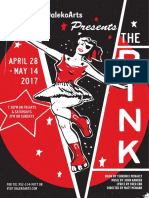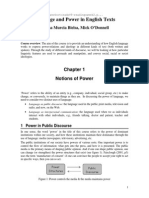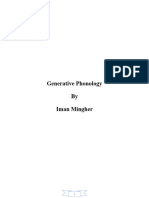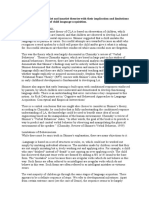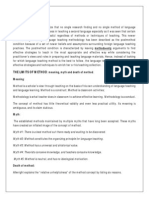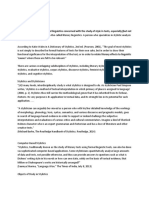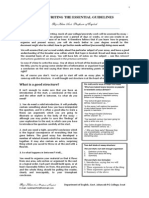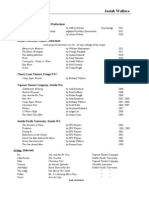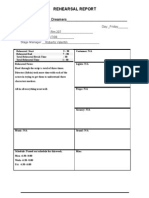Drama-Its Elements An Overview: Theme
Drama-Its Elements An Overview: Theme
Uploaded by
Rozi KhanCopyright:
Available Formats
Drama-Its Elements An Overview: Theme
Drama-Its Elements An Overview: Theme
Uploaded by
Rozi KhanOriginal Title
Copyright
Available Formats
Share this document
Did you find this document useful?
Is this content inappropriate?
Copyright:
Available Formats
Drama-Its Elements An Overview: Theme
Drama-Its Elements An Overview: Theme
Uploaded by
Rozi KhanCopyright:
Available Formats
Drama—its Elements an Overview
Drama on stage often reflects the drama of everyday life, but it also concentrates life, focuses it, and holds it
up for examination. Aristotle outlined some elements of drama in his critical analysis of the classical Greek
tragedy Oedipus Rex written by the Greek playwright, Sophocles, in the 5th century B.C. The elements
involve: Thought, Theme, Ideas; Action or Plot; Characters; Language; Music; and Spectacle. Since plays are
written with the intention of performance, the reader of the play must use their imagination to enact the
play as they read it.
Readers of the play need to imagine not just feelings or a flow of action, but how the action and the
characters look in a theatre, on a stage, before a live audience. Thus, there are many elements that make up
a drama. Right from the theme, plot of the play, till the costumes, dramatic representation to the audience
that actually makes the drama a success by viewing it. Thus, let us study the elements that encompass the
making of a drama.
Theme
It refers to what the play means as opposed to what happens (plot) or it refers to the main idea/ though/
theme within the play. Sometimes the theme is clearly stated in the title. It may be stated through dialogue
by a character acting as the playwright`s voice. Or it may be the theme is less obvious and emerges only after
some study or thought. It emerges from the abstract issues and feelings that grow out of the dramatic
action.
Plot
It refers to the order of the events that happen in a play. In actuality plot refers to what happens rather than
what it means. The plot is usually structured with acts and scenes and the action and movement in the play
begins from the initial entanglement, through rising action, climax, and falling action to resolution. The
interest generated by the plot varies for different kinds of plays. The plot of the drama can be shown in the
`through-line` with its beginning, middle and end - although it does not have to be presented in a linear
structure. The characters in a play are also part of the plot. The action of the drama consists in the events
that the characters take part in as they act the play. The content of the drama lies in the themes it deals
with, example bullying, the responsibilities of power and the bravery of ordinary people.
Audience
Theatre requires an audience, since live audience also has an important impact on the way plays are created.
The physical presence of an audience can change a performance, inspire actors, and create expectations.
The presence of live actors on the stage in front of live audiences sets it apart from modern day films and
television. The presence of live actors on the stage in front of live audiences sets it apart from modern day
films and television. Hence, authors calculate for the effect of the audience rather than for the silent
response. With this in mind, most plays written deal with topics that are timely in vogue.
Dialogues
Rozi Khan Department of English GPGJC, Swat
1
It refers to the word choices made by the playwright and the enunciation of the actors delivering the lines.
Language and dialogues delivered by the characters moves the plot and action along, provides exposition,
and defines the distinct characters. Thus, in short, the dialogues also provide the substance of a play.
Stagecraft
The stage creates its effects in spite of, and in part because of, definite physical limitations. Setting and
action tend to be suggestive rather than panoramic or colossal. Both setting and action may be little more
than hints for the spectator to fill out.
Convention
This is the starting point of the theatrical performance. This element is considered as the domain of the
playwright in theatre. It is the pure process by which the playwright`s work is brought to realization by the
director, actors, designers, technicians, dancers, musicians and any other collaborators that come together
on the script, scenario, or plan. This is that works in progress stage.
Genres
There are different genres of plays, which are divided into the categories of tragedy, comedy, melodrama,
and tragicomedy. Each of these genre/forms can be further subdivide by style and content.
Tragedy: Tragedy is an imitation of an action that is serious, complete and of a certain magnitude. The
tragedy is presented in the form of action, which will arouse pity and fear in the audience as it witnesses the
action. It allows for an arousal of this pity and fear and creates an effect of purgation or catharsis of these
strong emotions by the audience. Tragedy is serious by nature in its theme and deals with profound
problems. In classic tragedy and the modern problem play, tragedy is a play in which a central character
faces, and is finally defeated by, some overwhelming threat or disaster. The hero or heroine is an active
participant in the event through a tragic flaw, a shortcoming of the protagonist, i.e., pride, rashness,
indecision.
This reinforces the emphasis on action derived from character, which explains the psychological and moral
interest of much great drama. Another common type of tragedy focuses not only on what the protagonist
brings about but on how he meets his fate. Tragedy will involve the audience in the action and create
tension and expectation. Tragedy so defined celebrates the triumph of the human spirit over physical
necessity. With the climax and final end the audience will have learned a lesson and will leave the theatre
not depressed or sullen, but uplifted and enlightened.
Comedy: Comedy should have the view of a "comic spirit" and is physical and energetic. Traditionally
comedy and humour play is defined as a play that bestows on its characters good fortune, or more
popularly, a happy ending. In comedy there is absence of pain and emotional reactions. Different kinds of
comedy illustrate different ways a playwright may leaven grim truth with humor or temper the playful with
the serious. There are situation comedies, romantic comedies, sentimental comedies, dark comedies,
comedy of manners, and pure farce. The comic devices used by playwrights of comedy are: exaggeration,
incongruity, surprise, repetition, witticisms, and sarcasm. It may deal with the loves and jealousies of the
young, and the reluctance other elders to give their blessings or the necessary funds. The behavior of the
characters presented in comedy is ludicrous and sometimes absurd and the result in the audience is one of
correction of behaviors.
Rozi Khan Department of English GPGJC, Swat
2
Melodrama: Melodrama is drama of disaster and differs from tragedy significantly; the forces outside of the
protagonist cause all of the significant events of the plot. All of the aspects of related guilt or responsibilities
of the protagonist are removed. The protagonist is usually a victim of circumstance. He is acted upon by the
antagonist or anti-hero and suffers without having to accept responsibility and inevitability of fate.
Melodrama has a sense of strict moral judgment, where all issues are resolved in a well-defined way. The
good characters are rewarded and the bad characters are punished in a means that fits the crime.
Tragicomedy: Tragicomedy is the most lifelike of all of the genres. It is non-judgmental and ends with no
absolutes. It focuses on character relationships and shows society in a state of continuous flux. There is a mix
of comedy and tragedy side by side in these types of plays.
Characters
These are the people presented in the play that are involved in the perusing plot. Each character has a
distinct personality, age, appearance, beliefs, socio economic background and language in the play. A
playwright`s success ultimately depends on his ability to create a character that an actor can "bring to life".
Thus, the way an actor plays a role, using his/her acting skills to create a character in a drama, is known as
characterization.
Music
It means the sound, rhythm and melody of the speeches. Music can encompass the rhythm of dialogue and
speeches in a play or can also mean the aspects of the melody and music compositions as with musical
theatre. Each theatrical presentation delivers music, rhythm and melody in its own distinctive manner. But,
music can be included to mean all sounds in a production. Music can expand to all sound effects, the actor`s
voices, songs, and instrumental music played as underscore in a play. In the aspects of the musical the songs
are used to push the plot forward and move the story to a higher level of intensity. Composers and lyricist
work together with playwrights to strengthen the themes and ideas of the play. Character`s wants and
desires can be strengthened for the audience through lyrics and music.
Spectacle
The spectacle in the theatre can involve all of the aspects of visual elements of the production of a play; the
scenery, costumes, and special effects in a production. The visual elements of the play created for theatrical
event. The qualities determined by the playwright that create the world and atmosphere of the play for the
audience`s eye. It also refers to the shaping of dramatic material, setting, or costumes in a specific manner.
Each play will have its own unique and distinctive behaviors, dress, and language of the characters. The style
of a playwright is shown in the choices made in the world of the play: the kinds of characters, time periods,
settings, language, methods of characterization, use of symbols, and themes.
Dramatic Structure
It refers to the form of drama and the way the story is told, the way the characters play their parts, and/or
the way the themes are explored. Dramatic structure involves the overall framework or method by which
the playwright uses to organize the dramatic material and or action. It is important for playwrights to
establish themes but the challenge comes in applying structure to the ideas and inspirations. Understanding
basic principles of dramatic structure can be invaluable to the playwright. Most modern plays are structured
into acts that can be further divided into scenes. The pattern most often used is a method by where the
Rozi Khan Department of English GPGJC, Swat
3
playwright sets up early on in the beginning scenes all of the necessary conditions and situations out of
which the later conditions will develop. Generally the wants and desires of one character will conflict with
another character. With this method the playwright establishes a pattern of complication, rising action,
climax, and resolution. This is commonly known as cause to effect arrangement of incidents.
Contrast
The use of contrast in drama productions like stillness contrasted with activity, or silence contrasted with
noise - is a useful way to focus the audience`s attention. A drama being played with no change of pace or
rhythm, mostly fails to hold on to the audience`s interest, but can be brought to life with the use of
contrasting sights and sounds. An example of such contrast could be in a courtroom drama.
Symbols
Dramas are produced to a great extent through the use of symbols - or representations - standing in for real
things. Many of the following can be understood as symbols; like props, gestures, expressions, costume,
lighting and setting.
Most commonly in most of the drams screened today, the audience will find a mixture of all the elements
discussed above. Since many playwrights tend to utilize a bit of all the elements. But the examples cited
above are plays demonstrating one predominant element almost to the exclusion of the others. Thus, artistic
consideration in playwriting requires selection and arrangement. Art is skill acquired by experience, study,
and clear observations. Before writing a play it is important to understand the medium for which one writes.
Writing for the stage demands an understanding of two fundamentals: the essence of drama and the nature
of theatre.
Rozi Khan Department of English GPGJC, Swat
4
You might also like
- Murder On The NileDocument9 pagesMurder On The NileMariano Moscol0% (1)
- (Sheet) Gilbert & Sullivan - The Pirates of Penzance - Poor Wandering OneDocument6 pages(Sheet) Gilbert & Sullivan - The Pirates of Penzance - Poor Wandering Onecircleb6323100% (7)
- Pains of Youth (2014)Document6 pagesPains of Youth (2014)lilyscribeNo ratings yet
- The RinkDocument8 pagesThe RinkDalekoArts100% (1)
- Global PoetryDocument147 pagesGlobal PoetryRozi Khan67% (6)
- Modul Introduction Literary AppreciationDocument38 pagesModul Introduction Literary AppreciationBae ByNo ratings yet
- The Story of An Hour - Annotated GuideDocument2 pagesThe Story of An Hour - Annotated GuideRozi Khan83% (6)
- A Critical History of English Literature Volume 3 by David Daiches PDFDocument263 pagesA Critical History of English Literature Volume 3 by David Daiches PDFSunil Lohchab20% (5)
- Lesson Plan For CW Types of DramaDocument2 pagesLesson Plan For CW Types of DramaDiane Morales100% (2)
- Comedy of MannersDocument4 pagesComedy of MannersRakesh BanerjeeNo ratings yet
- GRADE 8 MUSIC 4th QUARTER PowerpointDocument43 pagesGRADE 8 MUSIC 4th QUARTER PowerpointJaypee Cancejo100% (3)
- Linguistic Stylistics - Gabriela Missikova Part2Document65 pagesLinguistic Stylistics - Gabriela Missikova Part2Romana ZápotockáNo ratings yet
- Language and Linguistics Unit 1Document7 pagesLanguage and Linguistics Unit 1MclyttleNo ratings yet
- Language PowerDocument27 pagesLanguage PowerAlfonso Cárdenas PáezNo ratings yet
- IC AnalysisDocument4 pagesIC AnalysisMd.Rabiul IslamNo ratings yet
- Freedom and Authority in EducationDocument3 pagesFreedom and Authority in EducationRozi Khan80% (20)
- Summary Notes Waste LandDocument14 pagesSummary Notes Waste LandRozi KhanNo ratings yet
- Drama "Absurdism" "The American Dream"Document3 pagesDrama "Absurdism" "The American Dream"Yasmina ZouabiNo ratings yet
- Syntax 1-Linguistics As A ScienceDocument2 pagesSyntax 1-Linguistics As A ScienceMeena RajNo ratings yet
- Language and VarietiesDocument20 pagesLanguage and VarietiesnafisaNo ratings yet
- General Characteristics of Phonemes: Aspects of Speech SoundsDocument8 pagesGeneral Characteristics of Phonemes: Aspects of Speech SoundsElina EkimovaNo ratings yet
- Group 6 - Incompatibility - Semantics A2Document8 pagesGroup 6 - Incompatibility - Semantics A2Heandhys EkaNo ratings yet
- Cultural Signs: MSJ 11351 Reading Media Texts: A Critical Introduction To Tareque MasudDocument18 pagesCultural Signs: MSJ 11351 Reading Media Texts: A Critical Introduction To Tareque MasudMD. Hasan Al MamunNo ratings yet
- Types and Characteristics of TranslationDocument4 pagesTypes and Characteristics of TranslationAcademic JournalNo ratings yet
- Grammar FinalDocument27 pagesGrammar Finalhuonglanle1230% (1)
- Assignment 1 Speech and Language (1,2,3,5)Document11 pagesAssignment 1 Speech and Language (1,2,3,5)Kyleruwlz FizrdNo ratings yet
- Exophora, Endophora, SubstitutionDocument21 pagesExophora, Endophora, Substitutionmythuan2709100% (2)
- Grammar and Syntax (Notes) - 1Document22 pagesGrammar and Syntax (Notes) - 1Saeed Ahmed Chachar100% (1)
- Applied LinguisticDocument23 pagesApplied LinguisticFatulous100% (1)
- ArticleDocument5 pagesArticleMah-e-noor Khan100% (1)
- Mental Grammar Trabajo IIDocument3 pagesMental Grammar Trabajo IIMayte Flores0% (1)
- Eng 323 Lecture 2Document4 pagesEng 323 Lecture 2maryjames ikebunaNo ratings yet
- PRAGMATICSDocument6 pagesPRAGMATICSAnne Santos CastroNo ratings yet
- Cognitive Science NotesDocument5 pagesCognitive Science NotesMaria BejanNo ratings yet
- Verse and Drama Unit 1-5Document23 pagesVerse and Drama Unit 1-5Ramzi JamalNo ratings yet
- Eng 123-Lesson3 Materials Evaluation-Dumilig - FiedacanDocument5 pagesEng 123-Lesson3 Materials Evaluation-Dumilig - FiedacanVeronica FiedacanNo ratings yet
- The Status of Linguistics As A ScienceDocument6 pagesThe Status of Linguistics As A SciencePriscila HernandezNo ratings yet
- An Introduction To Applied LinguisticsDocument30 pagesAn Introduction To Applied Linguisticspriya avaisNo ratings yet
- Ferdinand de SaussureDocument28 pagesFerdinand de SaussureRo Lu0% (1)
- Grammatical Categories & Word ClassesDocument45 pagesGrammatical Categories & Word Classesaila unnie100% (1)
- Stylistics .Script LanguageDocument11 pagesStylistics .Script LanguagekhanNo ratings yet
- 1 HockettDocument18 pages1 HockettMary-ElizabethClintonNo ratings yet
- (Semantic) - Word, Meaning and ConceptDocument13 pages(Semantic) - Word, Meaning and ConceptIan NugrahaNo ratings yet
- Generative PhonologyDocument20 pagesGenerative PhonologyAhmed MubarakNo ratings yet
- Introduction..Polysemy and HomonymyDocument6 pagesIntroduction..Polysemy and HomonymyClaudia Elena NegurăNo ratings yet
- Types of SyllabusDocument15 pagesTypes of SyllabusMc Monrey Bayot100% (1)
- Explain The Behaviourist and Innatist Theories With Their Implication and Limitations in Our Understanding of Child Language AcquisitionDocument4 pagesExplain The Behaviourist and Innatist Theories With Their Implication and Limitations in Our Understanding of Child Language AcquisitionTitly TropaNo ratings yet
- What Are The Different Levels of Linguistic Analysis - Determine The Relationship Between Linguistics and Other Disciplines.Document2 pagesWhat Are The Different Levels of Linguistic Analysis - Determine The Relationship Between Linguistics and Other Disciplines.Sabir Ansari100% (1)
- GratefulnessDocument16 pagesGratefulnessvinayakiNo ratings yet
- Psycholinguistics For Final ExamDocument12 pagesPsycholinguistics For Final ExamMohamed SelimNo ratings yet
- The Direct MethodDocument3 pagesThe Direct MethodSofinurdiyana SalehNo ratings yet
- Politics of Translation: - Gayatri Chakravorty SpivakDocument5 pagesPolitics of Translation: - Gayatri Chakravorty SpivakTina ThomasNo ratings yet
- Phonemes and MorphemesDocument1 pagePhonemes and MorphemesPuna Ram Ghimire100% (1)
- 1011-Semiotic AnalysisDocument19 pages1011-Semiotic AnalysisMainAdiNo ratings yet
- New Trends in PsycholinguisticsDocument7 pagesNew Trends in PsycholinguisticsWinston CastilloNo ratings yet
- StructuralismDocument4 pagesStructuralismHareem ZehraNo ratings yet
- Tribal Verse: G.N. Devy Look For These Expressions in The Text and Guess The Meaning From The ContextDocument13 pagesTribal Verse: G.N. Devy Look For These Expressions in The Text and Guess The Meaning From The ContextGod is every whereNo ratings yet
- Name: Areeba Haroon Roll No: DK2271Document3 pagesName: Areeba Haroon Roll No: DK2271Areeba HaroonNo ratings yet
- Communicative Competence and Language TeachingDocument10 pagesCommunicative Competence and Language TeachingyelfizamayendraNo ratings yet
- Morpho-Syntactic Properties of Kisukuma NounsDocument19 pagesMorpho-Syntactic Properties of Kisukuma NounsIJELS Research JournalNo ratings yet
- Postmethod Condition and PedagogyDocument4 pagesPostmethod Condition and PedagogyEmad JamshidiNo ratings yet
- Semantic Field TheoryDocument6 pagesSemantic Field TheoryJonathan Harker100% (1)
- The Functions of LanguageDocument7 pagesThe Functions of LanguageFlorinNo ratings yet
- Challenges in The Multilingual Classroom Across The Curriculum1Document13 pagesChallenges in The Multilingual Classroom Across The Curriculum1AJAY KUMAR BEHERANo ratings yet
- Riga Teacher Training and Educational Management Academy: Essay in English Lexicology English Words FormationDocument6 pagesRiga Teacher Training and Educational Management Academy: Essay in English Lexicology English Words FormationАнна ЖелобовскаяNo ratings yet
- BS English Course SyllabusDocument7 pagesBS English Course SyllabusInComplete Maseed0% (1)
- Is Language Innate or LearnedDocument2 pagesIs Language Innate or LearnedAhmed altaloolNo ratings yet
- Greek Theatre Vs Modern Day TheatreDocument3 pagesGreek Theatre Vs Modern Day TheatreShaZia Khan0% (1)
- StylisticsDocument3 pagesStylisticsAbdel MalekNo ratings yet
- Assignment: StructuralismDocument2 pagesAssignment: StructuralismGeorgeiyRoy100% (1)
- Elements of DramaDocument3 pagesElements of DramaCarl Cedrick NavarroNo ratings yet
- Thetheatre: Katrina Buhian, MaDocument32 pagesThetheatre: Katrina Buhian, MaApril Hilarylynn Lawa JagunosNo ratings yet
- Victorian Era England & LiteratureDocument9 pagesVictorian Era England & LiteratureRozi KhanNo ratings yet
- Romantic Poetry: Background Reaction To Earlier Age Main Features Who Were The Romantics?Document9 pagesRomantic Poetry: Background Reaction To Earlier Age Main Features Who Were The Romantics?Rozi KhanNo ratings yet
- Secret Sharer SummaryDocument14 pagesSecret Sharer SummaryRozi Khan100% (1)
- Precis Writing and ComprehensionDocument7 pagesPrecis Writing and ComprehensionRozi KhanNo ratings yet
- Projection PrincipleDocument2 pagesProjection PrincipleRozi Khan67% (3)
- Restoration PeriodDocument5 pagesRestoration PeriodRozi Khan100% (4)
- Allama IqbalDocument2 pagesAllama IqbalRozi KhanNo ratings yet
- My Voice ChockedDocument1 pageMy Voice ChockedRozi KhanNo ratings yet
- Why I Scribe AgainDocument1 pageWhy I Scribe AgainRozi KhanNo ratings yet
- Business CommunicationDocument2 pagesBusiness CommunicationRozi Khan50% (2)
- The Waste Land Section IIIDocument3 pagesThe Waste Land Section IIIRozi KhanNo ratings yet
- Reader Response TheoryDocument2 pagesReader Response TheoryRozi Khan100% (1)
- Punctuation: Why Do We Need Punctuation?Document19 pagesPunctuation: Why Do We Need Punctuation?Rozi KhanNo ratings yet
- Noam Chomsky: Norbert HornsteinDocument11 pagesNoam Chomsky: Norbert HornsteinRozi KhanNo ratings yet
- English Grammar A Short GuideDocument10 pagesEnglish Grammar A Short GuideRozi KhanNo ratings yet
- Grammatical Function: Syntactic Word Phrase Context Clause SentenceDocument3 pagesGrammatical Function: Syntactic Word Phrase Context Clause SentenceRozi KhanNo ratings yet
- What Is A Speech ActDocument5 pagesWhat Is A Speech ActRozi KhanNo ratings yet
- Rozi Khan Asst. Professor of English: Essay Writing The Essential GuidelinesDocument5 pagesRozi Khan Asst. Professor of English: Essay Writing The Essential GuidelinesRozi Khan100% (1)
- Guide To Guide To Technical Report WritingDocument5 pagesGuide To Guide To Technical Report WritingRozi KhanNo ratings yet
- Discourse AnalysisDocument3 pagesDiscourse AnalysisRozi KhanNo ratings yet
- Roman Theater at Aspendos-TurkeyDocument3 pagesRoman Theater at Aspendos-TurkeyJonathanDaysNo ratings yet
- Genres of Literature PDFDocument32 pagesGenres of Literature PDFmisaki takahashiNo ratings yet
- Raymond WilliamsDocument5 pagesRaymond Williamsmisan_1810100% (1)
- Drama Is EverywhereDocument2 pagesDrama Is EverywhereWalter Manzano JrNo ratings yet
- Ache Lhamo Tibetan TheatreDocument125 pagesAche Lhamo Tibetan TheatreAgrimaNo ratings yet
- Creative Writing SLM 1 QIV (LEA)Document12 pagesCreative Writing SLM 1 QIV (LEA)Letecia AgnesNo ratings yet
- Pat Kinevane - FORGOTTENDocument6 pagesPat Kinevane - FORGOTTENAle TPNo ratings yet
- 42nd St. Moon Audition FormDocument1 page42nd St. Moon Audition FormMadisonNo ratings yet
- History of Drama Ancient DramaDocument4 pagesHistory of Drama Ancient DramavhanAileeNo ratings yet
- Intercultural Theory and Semiotics 2008 PDFDocument14 pagesIntercultural Theory and Semiotics 2008 PDFFellype Diorgennes Cordeiro GomesNo ratings yet
- Introduction To Physical Theatre by Mrs JunaidDocument32 pagesIntroduction To Physical Theatre by Mrs JunaidJ R100% (4)
- Web Theatre Resume JosiahDocument2 pagesWeb Theatre Resume Josiahjosiah_wallace_2No ratings yet
- Brecht-Conversation About Being Forced Into EmpathyDocument5 pagesBrecht-Conversation About Being Forced Into Empathybibito_No ratings yet
- Aspects of ProductionDocument88 pagesAspects of ProductionBurning Rose50% (2)
- Blackwatch EssayDocument3 pagesBlackwatch EssayMelissa GartshoreNo ratings yet
- Why Ballet Is Out of The Limelight - Sri Lankan BalletDocument4 pagesWhy Ballet Is Out of The Limelight - Sri Lankan BalletIndeewara ThilakarathneNo ratings yet
- Theatre From Restoration Through RomanticismDocument3 pagesTheatre From Restoration Through RomanticismAnkita BoseNo ratings yet
- Front of HouseDocument13 pagesFront of HouseRomel ArriolaNo ratings yet
- History of DanceDocument151 pagesHistory of Dancenadynne_rjNo ratings yet
- Modern DrmaDocument7 pagesModern DrmaSHOAIBNo ratings yet
- Dissertation Le Theatre Et Sa RepresentationDocument5 pagesDissertation Le Theatre Et Sa RepresentationHelpWritingPapersForCollegeCanada100% (2)
- Rehearsal ReportDocument1 pageRehearsal ReportnewarkdreamersNo ratings yet



